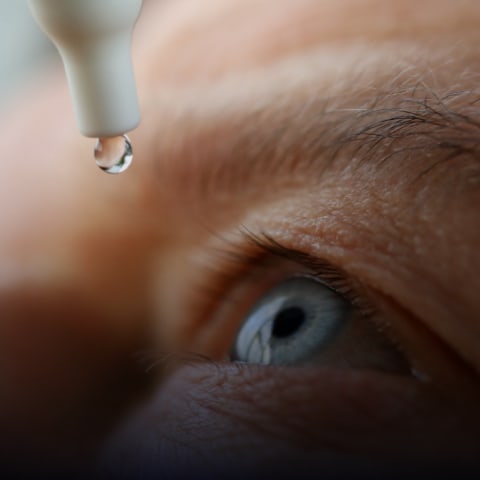Whether it’s from staring at a computer screen for too long or spending a day in the wind, dry eye discomfort can be frustrating. But what if you wake up with dry eyes, even after a good night’s sleep? This can be a sign of a bigger problem that requires attention.
Waking up with dry eye in the morning can result from dry bedroom air, sleeping with your eyes partially open, blepharitis, contact lens wear, or meibomian gland dysfunction.
If you’re waking up with dry eye, visit your optometrist for an eye exam and dry eye assessment to explore treatment options.
Why Are You Waking Up with Dry Eye?
Dry eye can develop at any time, but if you’re experiencing it when you first open your eyes to greet the day, it may be caused by a few reasons.
Lack of Moisture in the Bedroom
Morning dry eye may indicate that the air in your bedroom is too dry. This can be caused by several factors, including:
- Running the heat or air conditioning all night
- Using a space heater
- Living in a dry climate
To combat this problem, consider investing in a humidifier for your bedroom. This will add moisture to the air and help prevent your eyes from drying out.
Sleeping with Your Eyes Partially Open
Believe it or not, some people sleep with their eyes partially open. This can cause tears to evaporate more quickly and result in dry eyes. Nocturnal lagophthalmos is often caused by muscle weakness or paralysis in the face. It can just happen but may also occur due to:
- A stroke
- Trauma or injury
- Bell’s palsy
- A tumour
- Neuromuscular diseases
Consider speaking to your optometrist about using a sleep mask. This can help keep your eyes closed and prevent them from drying out overnight.
Blepharitis
Blepharitis is a condition that causes inflammation of the eyelids and can result in dry or very itchy eyes. Common causes include:
- Bacterial infection
- Dandruff
- Allergies
- Skin conditions
- Demodex skin mites
If you suspect you have blepharitis, speak to your optometrist about the right course of treatment.
Contact Lenses
If you wear contact lenses, they may be causing your eyes to dry out. Contact lenses can cause dry eye if:
- You’re wearing them too many hours a day
- You’re not replacing your lenses frequently
- You’re wearing the wrong type of lenses
Consider switching to a different lens type or speaking to your optometrist about contact solutions or lubricants that can help keep your eyes moist.
Meibomian Gland Dysfunction
The meibomian glands are located in your eyelids and produce an oil that helps prevent tears from evaporating too quickly. If these glands become clogged or dysfunctional, it can result in dry eyes.
These blockages inhibit healthy tear production, which can make waking up with dry eyes a common occurrence.

Treating Dry Eye
When dry eyes become disruptive and affect your quality of life, you should contact your Optometrist to explore various treatment options.
IPL (Intense Pulsed Light) Treatment
IPL treatment is a noninvasive procedure that uses light pulses applied to the eyelid. It is typically performed in a series of sessions, each lasting about 20 minutes.
IPL has been shown to be effective by:
- Facilitating meibomian gland expression
- Decreasing inflammation
- Reducing demodex mites
Radiofrequency Treatment
Radiofrequency treatment, or RF, uses energy to heat the gland responsible for producing tears. This helps to stimulate the gland and increase natural tear production.
RF therapy is typically performed with gland expression, which involves manually squeezing the blocked glands to release stagnant oils. This combination treatment has been shown to be effective in improving dry eye symptoms.
Meibomian Gland Expression
Gland expression is a manual procedure that involves applying gentle pressure on the blocked oil glands in the eyelids to release stagnant oils. This can help improve the quality of the natural tear film, reducing symptoms of dry eye.
While gland expression can be effective, it can also be combined with other treatments to promote healthy tears.
BlephEx
Blephex is another noninvasive procedure involving a specialized tool to remove eyelid debris and bacteria. When blepharitis contributes to dry eye, BlephEx can improve the function of the oil glands and promote better tear production.
Eye Drops
Eye drops are often the first line of treatment for dry eye. Many different types of eye drops are available, each with unique active ingredients and mechanisms of action. The most popular drops work by:
- Increasing tear production
- Reducing inflammation
- Lubricating the eye
It’s important to talk to an eye care professional to determine which type of eye drop will suit your needs.
Treat Dry Eye for Lasting Relief
Waking up with dry eyes can be frustrating and uncomfortable. By identifying the root cause of your dry eyes, you can take steps to alleviate the discomfort and prevent further damage. Schedule an eye exam at our locations in Calgary, Olds, Sundre, or Carstairs for an expert assessment.
With the right treatment plan, dry eye symptoms can be significantly reduced, allowing for improved comfort and better eye health.


































